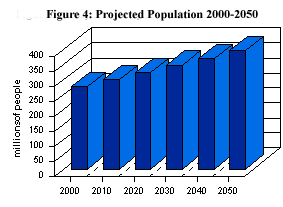Americans Have Spoken: No Further Population Growth
- Leon Bouvier
- September 1, 1997
- Special Report
- 0 Comments
Americans Have Spoken: No Further Population Growth
by Dr. Leon Bouvier
Senior Fellow, Negative Population Growth
Introduction
“The [optimal] balance, in the case of the United States, would seem to me to have been surpassed when the American population reached, at very maximum, two hundred million people, and perhaps a good deal less.” 1
These words written recently by one of the nation’s eminent statesmen are undoubtedly echoed, perhaps in less lucid terms, by millions of us. “The highways are too crowded. You can’t hardly use them anymore.” “Have you tried driving on the LA freeways lately? It’s next to impossible.” “Just going to the market is becoming an ordeal.” “I remember when we could go to the beach and enjoy ourselves. Now they’re too crowded.” “How about our national parks? Have you tried to even get into one of them?” “There’s just too many people nowadays.”
These are all irritants, but are tolerable. Granted that quality of life has deteriorated as our population soars, we simply have to adjust to more people, or so we’re told. When I was a child in the 1930s, it was such a pleasure to go to the beach. But then the nation’s population was less than 150 million. Today, we are approaching 270 million. (See Figure 1.) You can’t build more beaches, or public parks. Perhaps you can build more and more roads, or more and more lanes on those roads, but that simply aggravates an already critical traffic problem.
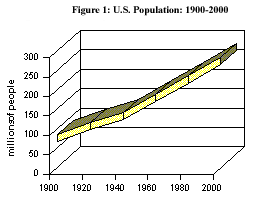 Yet, while such growth is causing us major difficulties, some economists and quasi-economists tell us that it’s good for the country to have more and more people. They insist that not only can we adjust to these problems, they actually reflect an improvement in our lifestyle!
Yet, while such growth is causing us major difficulties, some economists and quasi-economists tell us that it’s good for the country to have more and more people. They insist that not only can we adjust to these problems, they actually reflect an improvement in our lifestyle!
But these “experts” don’t tell us that each year we draw 25 percent more water from groundwater resources than are replaced by nature. They don’t tell us that, as a result, our aquifers are rapidly drying up. It is predicted by knowledgeable scientists that many large aquifers may be entirely depleted within 25 years.2 Can we accept the fact that the Everglades has already been reduced by half its original size? What about our waste deposits? We, as a nation, generate over 13 billion tons of waste each year. Of that, about 2 percent is identified as hazardous waste. That means each one of us generates about 50 tons of waste each year. Where will we put all that waste after we have added another 100 or 150 million more people?
 What about our schools? Quality—from kindergarten through college—is down and, to a great extent, that is due to larger classes especially in the lower grades, and in many areas in part because so many students do not speak English. Furthermore, while we desperately need more and more schools to take care of our growing population, a recent General Accounting Office study estimated that we must invest $112 billion to bring the infrastructure of schools back to acceptable levels.3 How much will it take to keep up with the soaring school-age population projected for the next few decades?
What about our schools? Quality—from kindergarten through college—is down and, to a great extent, that is due to larger classes especially in the lower grades, and in many areas in part because so many students do not speak English. Furthermore, while we desperately need more and more schools to take care of our growing population, a recent General Accounting Office study estimated that we must invest $112 billion to bring the infrastructure of schools back to acceptable levels.3 How much will it take to keep up with the soaring school-age population projected for the next few decades?
All these important problems are, at least in part, attributable to population growth. Yet, our policy makers seem convinced that nothing can be done about such growth, or perhaps many of them still don’t see it as a problem. Rather, we are supposed to accept that growth and adjust everything else to it. Build more roads (or add lanes); build more schools (or make classes larger and go to 12-month schedules), add more police and build more jails (without increasing taxes, of course). The list is endless.
Now, I must admit that growth is seductive. More people mean more stores and restaurants; more people mean more medical specialists; more people mean more jobs, though not always good ones. More people simply mean more, more, more.
But there are two sides to that argument. For a while, particularly in an underpopulated area, some growth is good. Every new resident contributes to lowering the cost of providing basic services to all—be they electricity, police protection, roads, schools, or libraries. These are economies of scale and reflect average costs, which are simply the result of dividing the total costs of the service by the total number of users.
In that sense, growth is good. But there is a limit to that growth. Sooner or later, the increased consumption means that much of the area’s infrastructure bumps up against its carrying capacity. More police must be hired; roads and schools no longer satisfy the needs of a growing population, and on and on. The result is diseconomies of scale. Growth, instead of lowering the average cost of services, eventually raises it. As Philip Longman writes: “once population growth becomes sufficient to cause diseconomies of scale, marginal cost, which is the cost of providing for one extra person or unit of consumption, begins to rise faster than average cost.” 4 Today, in the United States we have reached the point where we must live with the problems of “marginal costs” attributable to runaway population growth.
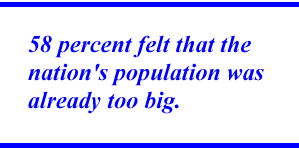 No small wonder then that we hear such expressions as cited above. “Too many people,” “Let’s stop growth,” “Enough, already,” etc. But are these the words of a small minority of malcontents, or is there a real concern among Americans that we, as a nation, have reached the point where marginal costs exceed average costs and, in a less pecuniary sense, where, very simply, quality of life just isn’t what it used to be? Is the American way of life, of which we were so proud at one time, a thing of the past?
No small wonder then that we hear such expressions as cited above. “Too many people,” “Let’s stop growth,” “Enough, already,” etc. But are these the words of a small minority of malcontents, or is there a real concern among Americans that we, as a nation, have reached the point where marginal costs exceed average costs and, in a less pecuniary sense, where, very simply, quality of life just isn’t what it used to be? Is the American way of life, of which we were so proud at one time, a thing of the past?
The 1995 Poll
A new poll sponsored by Negative Population Growth, Inc. (NPG), conducted in December of 1995, provides answers to these and many other questions. A total of 1,978 randomly selected adults were questioned face-to-face by professional interviewers. The replies to the questions are illuminating and should be required reading for our policy makers and the media.
Population Growth: For or Against
One of the questions in the poll deals directly with the issue of population size. Respondents were read the following statement and then asked the question: “The U.S. population was around 150 million in 1950. It is now 265 million. Do you think there are far too many people, somewhat too many people, somewhat too few people, far too few people, or about the right number of people?”
After subtracting the 9 percent who did not reply, 35 percent of the remaining respondents felt the nation had about the right number of people. Another 58 percent felt that the nation’s population was already too big. Thus, while one-third of the respondents were content with the present size of our population, no less than 93 percent of those who responded to this question did not want any further growth, and many favored population reduction. One-quarter of respondents felt that there were already “far too many people.”
What was particularly remarkable about the replies to this all-important question was their consistency. Ten widely different variables were included: gender, age, household income, education, occupation, geographic area, political affiliation and outlook, marital status, race, and religion. With rare exceptions, there was general agreement that “we’ve got enough, if not too many, people already.” Table 1 summarizes the findings, listing the percentage who feel that the population is already too large. (The calculation includes those who had no opinion on the issue.)
| Table 1 Percent of Respondents Who Feel U.S. Population Is Too Large, by Selected Characteristics |
|||
| Characteristic | Characteristic | ||
| Gender Male Female Age 18–29 30–44 45–59 60+ Household Income Under $15,000 $15,000–29,999 $30,000–49,999 $50,000–74,999 $75,000+ Political Affiliation Democrat Republican Conservative Middle of the Road Liberal Size of Household 1–2 3–4 5+ Religion Catholic Protestant Jewish* Other |
53 53 56 53 54 51 50 |
Education < 12 Years HS Graduate Some College College Graduate Occupation Exec/Prof White Collar Blue Collar Area Northeast Midwest South West Marital Status Total Married Both Work Single < 45 Children 0–7 Children 8–17 Race White African American Asian & Other* Hispanic |
51 57 53 48 54 55 52 53 |
|
* The number of cases in the sample was less than 100. Because of lack of sampling reliability, these will not be considered in our separate analyses but will be included in the overall study. |
|||
The consistency of replies is amazing. In two subgroups more than 60 percent of the respondents favored a smaller population. Among Hispanics, 64 percent held such a view and among people living in the western region, two-thirds favored a smaller population.
Concern about overpopulation may be stronger in the west because the current rate of growth is more rapid there and the negative effects of rapid growth are most keenly felt. Moreover, people who choose to live in the west are drawn to it by their preference for an open, low-density, low-pressure environment.
On the other hand, only among people living in the south (46%), and those with college degrees (48%) did less than half favor reductions in numbers. On 43 different indicators used to measure the ten variables, 38 fell between 50 percent and 59 percent.
The proportions replying “About the right number of people” also varied slightly among groups. Exceptions were the Hispanics (19%) and college graduates (41%). Hispanics are the most crowded group in the country, and this is reflected in their response to this question. Furthermore, many live in the west, which may also explain in part the high rate in that region.
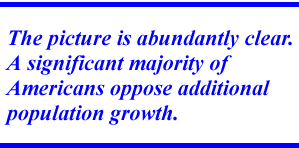 The picture is abundantly clear. A significant majority of Americans oppose additional population growth. The overall proportion who want no more growth (or a smaller number) is worth repeating: 86 percent of all respondents and 93 percent of those who actually replied to the specific question. No more than 4 percent of any group felt the country was vastly underpopulated. How much more of a mandate is needed to wake up our legislators in Washington?
The picture is abundantly clear. A significant majority of Americans oppose additional population growth. The overall proportion who want no more growth (or a smaller number) is worth repeating: 86 percent of all respondents and 93 percent of those who actually replied to the specific question. No more than 4 percent of any group felt the country was vastly underpopulated. How much more of a mandate is needed to wake up our legislators in Washington?
Furthermore these attitudes on the part of Americans are not new. According to the 1996 Task Force Report of the President’s Council on Sustainable Development (p.17):
For decades, Americans have not had a desire for an ever larger population. In 1974, 87 percent of respondents to a Roper poll said they did not wish the country had more people. A 1972 poll by the U.S. Commission on Population Growth and the American Future found that 22 percent felt the U.S. population should be smaller than it was then, which was close to 200 million. As long ago as 1947, when the U.S. population was 140 million, Gallup found that 55 percent of Americans believed the country would be “worse” off with more people. (emphasis added)
Now, it must be admitted that a fairly large minority of certain Americans favor population growth. While they are relatively small in number, they comprise a group, be they contractors, manufacturers, or just people who wish there were more fast-food restaurants within walking distance of their homes, who remain convinced that growth is a good thing. Their views cannot be ignored.
Population Size in Home Areas
It could be argued that while there is agreement that the U.S. population is too large (or large enough), such is not the case “in my home town.” Perhaps the problem exists only in large cities, or in some cases, in exactly those cities where people are moving away from them because of overcrowdedness. NPG asked: “Thinking about conditions around here where you live and the number of people who live in this area, we’d like to know what you would like to see happen to the population here in the next ten years. Would you regard this as a better place if there were a lot fewer people living here, somewhat fewer, somewhat more people living here, or a lot more people living here, or would you like it to stay about the same as it is now?”
Overall, 48 percent of all the respondents did not want any further growth (i.e., “Stay about the same as it is now”), 17 percent preferred more growth, and 28 percent wished the population would fall over the next ten years. (Six percent didn’t know.) Looking at all variables, generally only about half of the respondents were satisfied with the current size of their home area. Many more preferred fewer people than wanted more. Again, religion, political affiliation, income, etc. did not really matter. The pattern remained consistent. Roughly half of all respondents favored the current population size of their home towns.
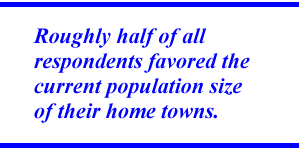 A few exceptions are worth mentioning. In the west region, only 32 percent were satisfied with the present population size, while 43 percent preferred fewer neighbors. As one Seattle resident commented on a recent Newsweek article lauding the city: “Seattle’s overcrowded, ‘too damn many people,’ griped a local.”5 Hispanic respondents also exhibited similar feelings — too many people around here. African Americans were not far behind. We suspect that this reflects big-city living. Hispanics and African Americans most directly experience the negative effects of crowded schools and housing, and the dilution of public services.
A few exceptions are worth mentioning. In the west region, only 32 percent were satisfied with the present population size, while 43 percent preferred fewer neighbors. As one Seattle resident commented on a recent Newsweek article lauding the city: “Seattle’s overcrowded, ‘too damn many people,’ griped a local.”5 Hispanic respondents also exhibited similar feelings — too many people around here. African Americans were not far behind. We suspect that this reflects big-city living. Hispanics and African Americans most directly experience the negative effects of crowded schools and housing, and the dilution of public services.
While the west includes such sparsely settled states as New Mexico, Idaho, and Montana, most of its population is concentrated in California and Arizona. Even in those other states, the population is highly urbanized. Indeed, Nevada, despite its small population, has a strong anti-population-growth sentiment, in part because of the explosive growth of Las Vegas. People living in those states are more likely to react negatively to additional growth in their home areas, which increasingly are merely suburbs in large metropolitan areas.
Only in the south did respondents favor more rather than fewer residents in their home areas—23 percent compared to 18 percent. Just over half were satisfied with present conditions. Despite the growth in states like Florida, where it is becoming a serious concern, the south remains relatively rural and thus may not see growth as an important problem.
Generally, those households earning higher incomes were more favorable to smaller “home town” populations than those with lower incomes. (See Figure 2.)
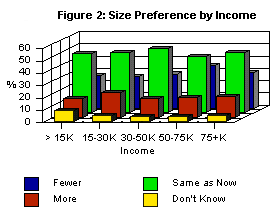 Overall, about half of all Americans would like to keep their home towns or cities at about their current size—no more growth. With but one exception, the south, of all the other respondents, many more would prefer fewer rather than more neighbors over the next ten years.
Overall, about half of all Americans would like to keep their home towns or cities at about their current size—no more growth. With but one exception, the south, of all the other respondents, many more would prefer fewer rather than more neighbors over the next ten years.
Again, the evidence is clear. Not only do a majority of Americans perceive the nation to be somewhat overcrowded, they generally feel the same way about the areas where they live. Yet, cities and states throughout the nation are constantly trying to lure more and more people to their jurisdictions. When will they learn that many people disagree with this flawed economic policy? On the other hand, of course, in a few areas people favor more growth.
Is Overpopulation a Major Problem?
As we approach the twenty-first century, the nation is faced with numerous problems: the economy, crime, the environment, etc. How does overpopulation rate? Do Americans consider it to be a major problem or is it merely something bothersome that we can live with, at least for the foreseeable future? We did grow from a nation of 75 million people at the turn of this century to 265 million today; why can’t we live with 275 million at the turn of the coming century? And if we added 200 million people over the twentieth century, why can’t we add another 200 million in the twenty-first century? In other words, while it may be a problem to some people, as we have seen, others might feel that population growth is something that we can adjust to as we have in the past.
We have been successful living in a rapidly growing country. How can continued growth be a problem? That’s the argument offered by proponents of continued growth. But how do the people of this country feel about such continued growth?
When asked for opinions on the statement: “Overpopulation is a major national problem that needs to be addressed now,” 55 percent were in agreement (24% strongly agreed). Another 20 percent weren’t certain. That is, they neither agreed nor disagreed. Only 21 percent felt that overpopulation was not a major problem. Perhaps even those who are not certain will change their minds over the next few years as growth continues unabated and suburbs are extended further and further away from the central cities and more and more lanes are added to our congested highways. At any rate, a majority of Americans do consider population growth to be a major problem, one that should be addressed now. (See Figure 3.)
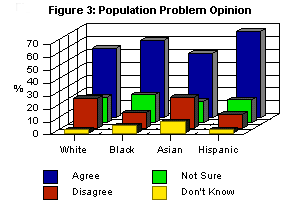
Consistency was noted here as in other responses in the survey with but one notable exception. Just under half (48%) of those earning at least $75,000 feel that overpopulation is a major problem. Otherwise, a majority of all respondents in all categories agreed with this statement. This was especially marked among residents of the west (66%), Hispanics (67%), and African Americans (60%). Thus some consistency exists within groups — especially regionally and ethnically.
The difference in attitude between Democrats and Republicans is minor. Whereas 58 percent of Democrats (including 28% who strongly agreed) feel that overpopulation is a major problem, the share among Republicans was 52 percent. At the other extreme, 17 percent of Democrats disagreed compared to 26 percent among Republicans. Most important is the fact that irrespective of political affiliation, there was agreement that population growth was a major problem.
Not only do Americans think we are overpopulated, whether nationwide or in one’s own area, Americans consider this a major national problem that needs to be addressed at this time. Yet not one word about population growth was mentioned during the ubiquitous Republican debates, and population growth was not discussed by either President Clinton or Senator Dole in their debates in the fall of 1996.
Recent Census Bureau and other projections foresee a population of close to 400 million Americans by 2050. (See Figure 4.) Some demographers criticize these projections as being too low. Indeed, a population of one billion Americans before the end of the next century is a definite possibility! Already, we are dangerously close to destroying our environment and exhausting our resources. Already, our schools are deteriorating, our wetlands are disappearing, we have no more room for waste disposal, and our parks and beaches are overcrowded. How will it be with 130 million more people living on the same amount of land? How will it be with a population double or even triple our current numbers? Will we simply keep building more schools (if we can find enough teachers), add more lanes to our highways, build new subdivisions and shopping malls? If we do, we must bear in mind that all this construction makes it more difficult for water to reach the aquifers. Instead, water simply contributes to more flooding. Asphalt and concrete cannot replace ground.
Respondents to the NPG poll were asked this question: “The current size of the U.S. population is 265 million. If present rates of fertility and immigration continue, our population will grow to around 400 million by the year 2050. . . . In your judgment, which of the following population sizes would be best for our country to have in the long run, say by 2050 and beyond?” Almost 60 percent answered 265 million or less — that is to say, our current population. About 38 percent were satisfied with our present size and another 22 percent preferred population decline. In other words, six out of ten Americans are satisfied with current levels of population but quite a few would prefer a smaller number. (See Figure 5.)
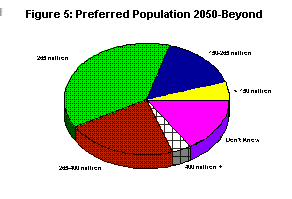 At the risk of boring diffuseness, I must repeat that word once again: consistency. The highest proportions preferring current or smaller population are found among those earning $50,000 or more (63%). At the other extreme, African Americans have the lowest shares (46%). The proportion opting for over 400 million, a size that has been advocated by certain economists, is minuscule: 4 percent overall. However, among African Americans it rises to 8 percent. One can’t help wondering if this is a wish to see their share of the U.S. population increase, particularly in light of the fact that it has been highly publicized that Hispanics may surpass African Americans in numbers within two decades. Ironically, Hispanics may feel crowded but have the highest fertility!
At the risk of boring diffuseness, I must repeat that word once again: consistency. The highest proportions preferring current or smaller population are found among those earning $50,000 or more (63%). At the other extreme, African Americans have the lowest shares (46%). The proportion opting for over 400 million, a size that has been advocated by certain economists, is minuscule: 4 percent overall. However, among African Americans it rises to 8 percent. One can’t help wondering if this is a wish to see their share of the U.S. population increase, particularly in light of the fact that it has been highly publicized that Hispanics may surpass African Americans in numbers within two decades. Ironically, Hispanics may feel crowded but have the highest fertility!
It should also be pointed out that 5 percent of the respondents felt that less than 150 million was the ideal population size for the nation. Interestingly, only Hispanics had a much higher share in that category. There, one in ten favored such a smaller population. Thus, the perceived “wish” of African Americans to see their population increase its portion of the total is not shared by the other large minority—Hispanics.6 However, over one in five of all respondents preferred a smaller population for 2050 than we have today. Thus, a clear majority of Americans (almost 60 percent) indicated that they prefer a U.S. population either smaller than, or not greater than, our present size of 265 million. However, the concept of reducing population size was not well received by most respondents.
Many other population-related questions were included in the survey. The replies are quite similar to those noted above and are summarized in Table 2.
| Table 2 Attitudes Toward Population Size and Growth (% strongly/mostly agree) |
|
| Although the issue of population growth does not require immediate attention, we should start thinking of ways to control it now.
Continued population growth is a threat to America’s resource base. The United States is a huge country with plenty of space for more population growth. To maintain a sound economy and environment for the long term, the United States needs to reduce its population size. This country needs population growth in order to have economic growth. We need continued population growth to avoid a labor shortage. Unless the U.S. population continues growing we will cease being a world power. |
59%
50% 36% 33% 30% 21% 20% |
The results are abundantly clear—a majority of Americans feel that enough is enough. We have seen our numbers rise almost fourfold in this century. Since 1950 alone, our numbers have almost doubled. It is time to re-examine our demographic situation and begin thinking of a population policy for the next century. Are we really prepared for 500 million inhabitants? The people have spoken; now it is up to the media to make this known, and especially for policy makers to act accordingly.
Ending Population Growth
Although a majority of Americans favor an end to growth (indeed, many prefer a smaller population), the next question is more difficult. How does a nation put an end to population growth, much less reduce its size? For years there was one answer and, in the 1960s, it was very popular: “Stop having so many children.” Zero population growth (ZPG) became a well-known expression. And indeed, this is an excellent way to reduce population growth. “Stop at Two” should become our motto in the twenty-first century.
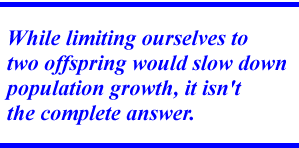 Unfortunately, even if we did “stop at two” and there was no immigration, population would still grow for some time because of what demographers call a “momentum for growth.” As long as there is a sufficient number of women in their childbearing years, the number of births will increase simply because so many potential mothers are available to have those “two” births. Thus, while limiting ourselves to two offspring would slow down population growth, it isn’t the complete answer.7
Unfortunately, even if we did “stop at two” and there was no immigration, population would still grow for some time because of what demographers call a “momentum for growth.” As long as there is a sufficient number of women in their childbearing years, the number of births will increase simply because so many potential mothers are available to have those “two” births. Thus, while limiting ourselves to two offspring would slow down population growth, it isn’t the complete answer.7
Populations change numerically in only three ways: births, deaths, and migration. No one advocates that we start dying younger to reduce the population. But reducing the level of immigration is a quick and relatively simple way to put an end to rapid population growth. More and more in recent years, “stop at two” has been accompanied by “lower immigration” as yet another way to reduce and eventually end population growth.
Attitudes Toward Immigration
Americans have long believed that immigration should be reduced and that illegal immigration should be ended. Poll after poll has documented these sentiments. Yet, as recently as 1990 the U.S. Congress increased legal immigration and in 1996 overwhelmingly turned down an attempt to reduce legal immigration by about 20 percent. All this despite massive majorities of Americans favoring reductions!
| Table 3 Percent of Respondents Who Feel the United States Should Accept Fewer than 300,000 Immigrants Per Year, by Selected Characteristics |
|||
| Characteristic | Characteristic | ||
| Gender Male Female Age 18–29 30–44 45–59 60+ Household Income Under $15,000 $15,000–29,999 $30,000–49,999 $50,000–74,999 $75,000+ Political Affiliation Democrat Republican Conservative Middle of the Road Liberal Size of Household 1–2 3–4 5+ Religion Catholic Protestant Jewish* Other |
70 71 67 71 70 71 68 |
Education < 12 Years HS Graduate Some College College Graduate Occupation Exec/Prof White Collar Blue Collar Area Northeast Midwest South West Marital Status Total Married Both Work Single < 45 Children 0–7 Children 8–17 Race White African American Asian & Other* Hispanic |
69 73 69 66 69 64 72 71 |
|
* The number of cases in the sample was less than 100. Because of lack of sampling reliability, these will not be considered in our separate analyses but will be included in the overall study. |
|||
With the passage of the 1965 immigration legislation, immigration levels began to increase from around 300,000 to over 800,000 per year in the 1980s. Although the number fell slightly in 1995, it did increase dramatically in 1996 to 915,900.8 When we add to that refugees and illegal immigrants, it is safe to say that well over one million people permanently enter the United States every year. This number is even greater than that recorded in the early part of the twentieth century when so many people came to the United States from eastern and southern Europe. Small wonder then that so many Americans say “enough is enough,” or, as former Senator Alan Simpson has put it: “We are suffering from compassion fatigue.”
Furthermore, lowering immigration levels as soon as possible is the quickest way to end, or at least reduce, population growth. Immigration advocates have been discussing the wrong issues. The issue is not cultural or racial as at least one former presidential candidate claims; the issue is not primarily whether immigrants take or don’t take jobs from Americans—they do. Very simply, and paraphrasing James Carville in the 1992 presidential election campaign, “It’s the numbers, stupid!”
Attitudes About Immigration
Respondents to the NPG poll were asked the following question: “Legal and illegal immigration combined has exceeded one million people a year in recent years. What do you think would be the most desirable number of all types of immigrants to allow into the United States each year?” Seven out of ten respondents replied that they would prefer total immigration to be under 300,000 annually.9 One in five would allow no immigrants whatsoever. Some 54 percent preferred fewer than 100,000 or none at all. When one takes into consideration the fact that 15 percent of the respondents didn’t reply, this means that over 83 percent of all those who answered the question felt that less than 300,000 immigrants per year was sufficient. An infinitesimally small proportion (2%) felt that immigration should be increased — that is, over one million per year.
As with the first question on population views, the various categories by percent favoring less than 300,000 immigrants per year are listed in Table 3. These numbers illustrate once again the amazing consistency that was found in most of this survey. Some variations are noted in views on immigration levels. In almost all instances, between 65 and 75 percent of respondents agreed that fewer than 300,000 immigrants should be accepted in any given year. However, a few exceptions were noted. Especially noteworthy was the smaller proportion of Hispanics who favored lower levels of immigration. While over half of Hispanics (52%) still thought 300,000 was a maximum number, this was far lower than the average of 70 percent. Nevertheless, a majority of Hispanics still want less immigration than now. Otherwise, only residents in the northeast had such a low proportion. One can’t help wondering if ethnicity is a factor in the low proportion for Hispanics. Recall that Hispanics favor reduced population size, yet some may wish to be reunited with their compatriots in the United States.
Of all the polls taken in recent years, this is the most convincing. The American people want to drastically reduce immigration. Yet the U.S. Senate, even after these data were announced, voted 80 to 20 against any minor reductions in legal movements.
Thus far, I have concentrated on legal immigration. But undocumented movements have increased dramatically in recent decades despite a 1986 law making it illegal to hire nonlegal immigrants. How many enter the country and stay remains a guess. The INS estimates that perhaps 300,000 illegal residents move permanently to the United States every year. Others have argued that this is a conservative estimate. There is little doubt that the actual number residing here surpasses five million.
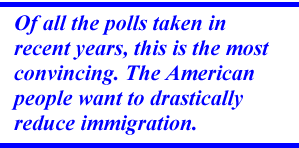 The NPG poll listed a number of statements related to population growth and asked the respondents if they agreed or disagreed with them. One of those statements read: “We should have strict laws to identify and deport illegal aliens already in this country.” Just under three-quarters of all respondents agreed (12 percent neither agreed nor disagreed). However, the level of agreement among groups was not as consistent as in earlier questions. In eight groups, less than 70 percent agreed with the statement: these included those earning under $15,000 (68%) as well as those earning over $75,000 (69%), those living in the northeast (63%), African Americans and Hispanics (68% and 60% respectively), and Catholics (69%). Quite possibly some of the respondents earning under $15,000 are illegal themselves; while some of those earning over $75,000 benefit from the hiring of illegals. College graduates were also less likely to advocate deportation than their less educated counterparts.
The NPG poll listed a number of statements related to population growth and asked the respondents if they agreed or disagreed with them. One of those statements read: “We should have strict laws to identify and deport illegal aliens already in this country.” Just under three-quarters of all respondents agreed (12 percent neither agreed nor disagreed). However, the level of agreement among groups was not as consistent as in earlier questions. In eight groups, less than 70 percent agreed with the statement: these included those earning under $15,000 (68%) as well as those earning over $75,000 (69%), those living in the northeast (63%), African Americans and Hispanics (68% and 60% respectively), and Catholics (69%). Quite possibly some of the respondents earning under $15,000 are illegal themselves; while some of those earning over $75,000 benefit from the hiring of illegals. College graduates were also less likely to advocate deportation than their less educated counterparts.
At the other extreme, 82 percent of Protestants favored the statement, as did 84 percent of people living in the midwest. Otherwise, most other groups hovered around 75 percent. Here, then, we see one of the few instances where Catholics and Protestants differ rather significantly on one of these issues. Only 69 percent of Catholic respondents agreed with this statement. Recall that Pope Paul visited the United States in 1996 and urged the admission of more immigrants. He did not distinguish between legals and illegals. His views may have had some impact on a few Catholics.
Looking at both immigration-related questions, it is clear that an overwhelming majority of Americans favor dramatic reductions — whether of legal or illegal movements. However, minorities are not as strongly convinced of the need for such reduction as others. This may reflect their desire to have more of their countrymen and countrywomen join them in the United States. However, it is important to add that despite these variations, even these groups favor immigration reductions.
Attitudes Toward Reduced Fertility
In the long run, reductions in fertility are more important than reductions in immigration if the goal is to level off and eventually reduce population size. However, because of the momentum for growth mentioned earlier, any reductions in fertility are slow in showing results. When the impact is finally felt, however, it is enormous. Consider this example from the 1992 Census Bureau projections. Holding constant both immigration and mortality, if fertility remained at 2.1 births per woman the 2050 population was projected to reach 383 million. Maintaining the same levels of immigration and mortality, if fertility fell gradually to 1.8 births per woman, the 2050 population would be 340 million — a difference of 43 million people in less than 60 years! Not only does this illustrate the importance of a small difference in family size, it should warn us of the need to reduce our fertility if we are to assure ourselves that the nation’s population does not increase much more, and perhaps, begins to decline in the future.
Currently U.S. fertility is around 2.1 births per woman, which is among the highest of any industrial nation. In Spain and Italy, for example, it is down to 1.2, and is 1.3 in Germany. Our current fertility, combined with our high level of immigration, almost guarantees that we will reach, if not surpass, 400 million by mid-twenty-first century and possibly come close to 1 billion by the end of the next century. Most Americans would agree that such an eventuality cannot be allowed to transpire. Given the momentum for growth, now is the time to act to stop this population juggernaut.
NPG did not inquire about ideal family size or such related matters. Numerous polls have been done in the past and the Census Bureau annually asks a large sample of American women their fertility plans. For some time now, the answer has been around 2.0 or 2.1. According to the latest Census Bureau projections using 1995 data, the total fertility rate for non-Hispanic white women is 1.8, for blacks 2.4, Asians 1.9, Native Americans 2.1, and Hispanics 3.0.10
The current poll emphasized policy-related questions dealing with how fertility could be reduced. The following statement was read to all respondents and they were asked to agree or disagree: “To encourage couples not to have more than two children, the federal government should give an income tax credit to people who have two or fewer children. If they have more than two children they would lose the credit.” Only 36 percent of the respondents agreed with this statement while 47 percent disagreed. About 14 percent couldn’t make up their minds; that is, they neither agreed nor disagreed. Overall, then, a plurality of respondents disagreed with the statement, which admittedly is a radical departure from current tax policies. For example, both parties and the President recently agreed to reward families for having additional births with a $500 tax credit from their actual income tax for each additional child. (See Figure 6.)

Variations from the overall average were rare. The highest percent agreeing with the statement were Hispanic respondents (49%). This is quite surprising and may reflect a desire on their part to begin limiting their high fertility. Other groups where the agreement share surpassed 40 percent were the executive/professionals (43%), and westerners (42%). Interestingly, agreement generally rose with the age of respondent.
On the other hand, low (i.e., under 30%) proportions in agreement with the statement were found only among African Americans (28%). In sum, while a plurality disagreed with this statement, so many were not sure that it could almost be called a “wash.” In fact, only among those families with children between 8 and 17 did over half disagree with the statement.
The U.S. adolescent pregnancy rate is among the highest in the industrialized world and is climbing. Many of these pregnancies are to single women. Sex education in schools has become a controversial issue in many areas as the religious right attempts to take over school boards in an effort to bar any discussion of sexual activities. With that in mind the following statement was included in the poll: “To try to reduce teen-age pregnancies, the federal government should pay all women between the ages of 14 and 19 a monthly cash stipend as long as they remain childless.”
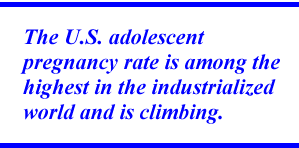 Although 30 percent agreed with the statement, 57 percent disagreed. Another 10 percent weren’t sure either way and 3 percent just didn’t know. This, of course, is another fairly radical solution to our soaring teenage pregnancy rate and such an approach has been suggested in other countries. The only groups where less than half of the respondents disagreed with the statement were African Americans (42%) and Hispanics (36%), suggesting a possible desire to limit family size among these groups. As for the others, perhaps financial concerns played a role in the decision-making process. No mention was made of how the money for these young women would be raised.
Although 30 percent agreed with the statement, 57 percent disagreed. Another 10 percent weren’t sure either way and 3 percent just didn’t know. This, of course, is another fairly radical solution to our soaring teenage pregnancy rate and such an approach has been suggested in other countries. The only groups where less than half of the respondents disagreed with the statement were African Americans (42%) and Hispanics (36%), suggesting a possible desire to limit family size among these groups. As for the others, perhaps financial concerns played a role in the decision-making process. No mention was made of how the money for these young women would be raised.
Americans have long had an aversion to increased taxes, even when it helps preserve our environment (witness the political squabble over a mere 4.3 cent tax on gasoline!). In addition, welfare has become a major issue in current policy discussions. Although it is a wild exaggeration, many middle-class Americans have visions of these huge poor families living on welfare and having more and more children just to get additional funds from the government. While studies have proven this not to be the case, it has become an accepted myth by many Americans.
Poorer families do have more children than their more affluent counterparts although the difference is not enormous. To get at the thinking of Americans on this subject the following statement was made and respondents were asked to agree or disagree: “The federal government should provide free sterilization for any low-income men and women of childbearing age who voluntarily choose it.” More than twice as many respondents agreed with the statement as disagreed (58% to 28%). Another 11 percent were uncertain and 3 percent didn’t know. (See Table 4.)
| Table 4 Percent of All Respondents Who Feel The United States Should Provide Free Sterilization, by Selected Characteristics |
|||
| Characteristic | Characteristic | ||
| Gender Male Female Age 18–29 30–44 45–59 60+ Household Income Under $15,000 $15,000–29,999 $30,000–49,999 $50,000–74,999 $75,000+ Political Affiliation Democrat Republican Conservative Middle of the Road Liberal Size of Household 1–2 3–4 5+ Religion Catholic Protestant Jewish* Other |
59 57 62 59 59 56 54 |
Education < 12 Years HS Graduate Some College College Graduate Occupation Exec/Prof White Collar Blue Collar Area Northeast Midwest South West Marital Status Total Married Both Work Single < 45 Children 0–7 Children 8–17 Race White African American Asian & Other* Hispanic |
58 54 62 57 58 44 57 58 |
In only one instance did less than 50 percent agree: northeasterners (44%). Many simply couldn’t come to a conclusion. In numerous cases, the proportion agreeing with the statement easily surpassed 60 percent. When we consider that those who couldn’t decide one way or another are included in these percentages, it seems quite clear that a substantial majority of the American people (including those earning under $30,000 annually) favor this suggestion. Interesting was the fact that 54 percent of Catholics agreed with the statement on sterilization. However, the percent of Protestants agreeing was substantially higher (62 %).
What About a National Policy?
In 1969, President Nixon spoke out forcefully, and as it turned out, prophetically, about population growth. His words are worth repeating:
In 1917 the total number of Americans passed 100 million, after three full centuries of steady growth. In 1967 — just half a century later — the 200 million mark was passed. If the present rate of growth continues, the third hundred million persons will be added in roughly a thirty-year period. This means that by the year 2000, or shortly thereafter, there will be more than 300 million Americans.
The growth will produce serious challenges for our society. I believe that many of our present social problems may be related to the fact that we have had only fifty years in which to accommodate the second hundred million Americans…
Where, for example, will the next hundred million Americans live?…
Other questions confront us. How, for example, will we house the next hundred million Americans?…
How will we educate and employ such a large number of people? Will our transportation systems move them about as quickly and economically as necessary? How will we provide adequate health care when our population reaches 300 million? Will our political structures have to be reordered, too, when our society grows to such proportions?…
…we should establish as a national goal the provision of adequate family planning services within the next five years to all those who want them but cannot afford them.11
These words are as appropriate today as they were in 1969. Nixon went on to propose, and Congress formed, a National Commission on Population Growth and the American Future. It was chaired by John D. Rockefeller, III. Its recommendations, published just 25 years ago, should be must reading for all Americans concerned with how we will handle yet another 100 million or more people in another fifty years. The Commission concluded: “After two years of concentrated effort, we have concluded that, in the long run, no substantial benefits will result from further growth of the Nation’s population, rather that the gradual stabilization of our population would contribute significantly to the Nation’s ability to solve its problems.”12 At that time, the U.S. population was a little over 200 million.
Apparently, the American people have been more likely to listen to the Commission’s views than their leaders. Indeed, Nixon himself disavowed the Commission’s report because of its family-planning recommendations. Since then, except for some brief activities during the Carter administration, population growth has ceased being an issue that our national leaders are willing to consider.
Yet, the people have spoken in no uncertain terms and their thinking is summarized below:
- A large majority of Americans want no further growth of the nation’s population and many would like to see its size reduced.
- A plurality consider their own home areas to be large enough and would prefer fewer rather than more neighbors.
- Most Americans consider overpopulation to be a problem that should be addressed immediately.
- An overwhelming majority of Americans think that immigration levels are far too high and should be reduced to less than 300,000 per year.
- Most Americans want to see illegal immigrants identified and deported from this country.
- While there is opposition to paying women 14–19 not to have children, those opposed only constitute a plurality of all respondents. A significant minority agree with the concept.
- A majority of Americans think the government should provide free sterilization for any low-income men and women of childbearing age who voluntarily choose it.
- Finally, almost 60 percent of Americans don’t want their population to grow beyond current levels by the year 2050.
The message is clear. The American people have spoken: no further growth.
Not all the results from this survey are encouraging to advocates of a smaller optimum population. NPG has long favored an eventual U.S. population of about 150 million.13 Recall the words of George Kennan on this subject. Nevertheless, we were encouraged by the backing shown for a national population policy which would have as its goal a smaller U.S. population. Support for such a policy was substantial (29 percent or almost one in three), even though it is not yet the view of the majority.
When asked if the U.S. Congress “should legislate a national policy to keep the population at a fixed level. That policy would set a specific numerical goal for a smaller U.S. population with a target date to reach that goal,” 41 percent of the respondents opposed such an approach while 29 percent favored it. Another 20 percent were not sure.
Opinions were quite consistent across the board with the exception of region. As Figure 7 shows, 40 percent of the people residing in the west favored such a proposition compared to only 22 percent among northeasterners. This, of course, reflects the pattern noticed throughout this study. Westerners are the most adamant foes of overpopulation.
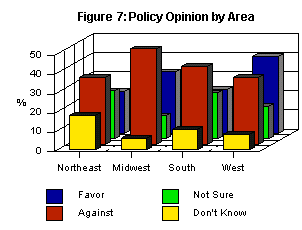
No question about it: a majority of the American people oppose further growth and they would like to see immigration drastically reduced. But, when it comes to fertility and official national policy, there is some hesitation. Part of that hesitation may come from the implication of governmental intervention. There is a growing dissatisfaction with governmental activities that affect the lives of individual Americans.14
However, Americans should realize that population growth, in and of itself, contributes tremendously to limiting individual freedoms. Small, underpopulated areas need far fewer regulations than overcrowded metropolises. As numbers grow, new rules become mandatory. Laws must be passed to determine speed limits; zoning regulations become necessary; environmental regulations are imperative. This is a basic aspect of population growth—the more people in any given space, the more regulations are needed to regulate social behavior. This is a prime reason why I, for one, would favor a decline in numbers. Fewer people means more freedom for all of us.
 Based on the results of our poll, a majority of Americans don’t want any further population growth, but they are hesitant about the government becoming involved, except insofar as immigration is concerned. There is also some concern about the word “negative.” Most Americans agree that the government should not become involved in determining family size, as it does in China. However, it should be noted that the U.S. government has historically taken pronatalist positions. The Comstock Laws of the nineteenth century, which banned even the mailing of family-planning literature and the prohibition of abortions, were forms of government interference in family size (favoring larger, not smaller, as in China).
Based on the results of our poll, a majority of Americans don’t want any further population growth, but they are hesitant about the government becoming involved, except insofar as immigration is concerned. There is also some concern about the word “negative.” Most Americans agree that the government should not become involved in determining family size, as it does in China. However, it should be noted that the U.S. government has historically taken pronatalist positions. The Comstock Laws of the nineteenth century, which banned even the mailing of family-planning literature and the prohibition of abortions, were forms of government interference in family size (favoring larger, not smaller, as in China).
Despite hesitancy about government involvement in fertility, the government does have the right to study how population growth is affecting every phase of American life. It has the right to encourage people to stop at two—a motto that we strongly urge be accepted by all Americans from this moment on.
Given the results of this poll, the government should be responsive to the wishes of its constituents by reducing immigration substantially and by seeking acceptable ways to encourage lower fertility and discourage population growth. Because of the momentum built into population growth, the time to act is now.
1. George Kennan, Around the Cragged Hill: A Political and Personal Philosophy (New York: W.W. Norton, 1993), 100. Concern about the population size of the United States is not new. For example, see the following quotation from Ralph Waldo Emerson: “If government knew how, I should like to see it check, not multiply, the population. When it reaches its true law of action, every man that is born will be hailed as essential.” (“The Conduct of Life, Considerations by the Way,” 1860).
2. Malin Falkenmark and Carl Widstrand, “Population and Water Resources: A Delicate Balance,” Population Bulletin 47, no. 3 (November 1992): 13.
3. Cited in Peter Peterson, “Social Insecurity,” Atlantic Monthly (May 1996): 64.
4. Phillip Longman, “We’re in the Tax Revolt Zone,” Florida Trend (October 1992): 18.
5. Newsweek, “Settling on Seattle,” 10 June 1996, 15.
6. It should be pointed out that only English-speaking Hispanics were included in the survey, which was conducted solely in English. Thus, this may reflect the thinking of second-generation Hispanics more than newcomers to the United States.
7. “Stop at Two” if observed by all would actually mean that the fertility rate would be around 1.5 since a number of women have one child and quite a few remain childless.
8. Compiled from wire reports. “Immigration Surges to 4-Year High,” Orlando Sentinel, 5 May 1997.
9. The posed legislation offered in the Congress in 1996 would have reduced it by a mere 20 percent, to still well over 500,000!
10. Jennifer Cheeseman Day, Population Projections of the United States by Age, Sex, Race, and Hispanic Origin: 1995 to 2050, U.S. Bureau of the Census, Current Population Reports, P25-1130 (Washington, D.C.: U.S. Government Printing Office, 1996), 2. It should be added that much of the variation in fertility between racial groups can be explained by differences in income and education. For example, college-educated black women have the lowest rate of all groups.
11. President Richard Nixon, “Special Message to the U.S. Congress on Problems of Population Growth, July 18, 1969,” in Public Papers of Presidents of the United States (Washington, D.C.: Office of the Federal Register, 1969), 521.
12. Cited in David Simcox, “The Commission on Population Growth and the American Future: Twenty Years Later: A Lost Opportunity,” in Social Contract (Summer 1992): 197.
13. It should be emphasized that Negative Population Growth does not advocate a permanent negative rate of population growth. That would eventually result in zero population! It advocates a negative rate of growth only for an interim period until U.S. population can be stabilized at a sustainable level, which we judge to be not over 150 million.
14. On that point, it is interesting to note that such intervention doesn’t seem to bother the so-called “right to life” movement advocating an anti-abortion Constitutional amendment. I can’t think of any more personal intervention by government than in a family’s bedroom!
See the Associated Press story on the Roper Poll
See the Executive Summary of the Roper Poll

